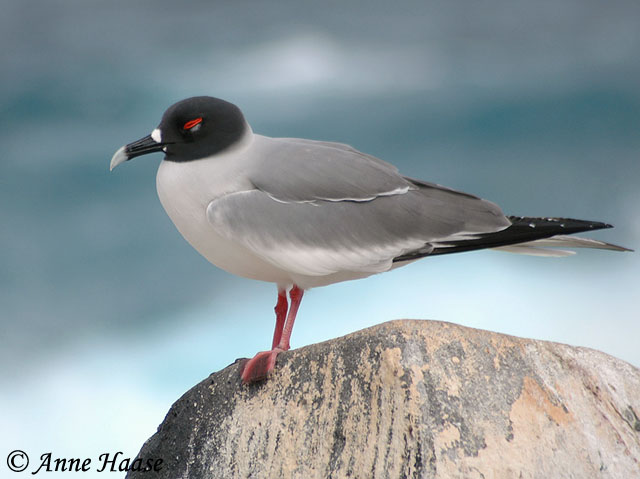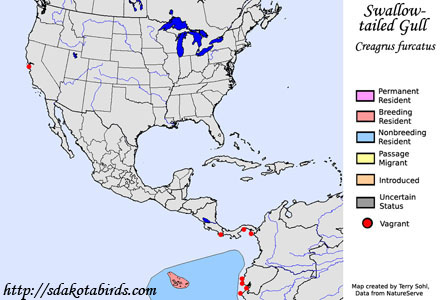| Length: 20 inches | Wingspan: 45 inches | Seasonality: Non-resident in South Dakota |
| ID Keys: Breeding Plumage: Dark head, long black bill with gray tip, red orbital ring, gray upperparts, white underparts. In non-breeding plumage, the head is white, and the orbital ring is black. | ||
 The
Swallow-tailed Gull is a beautiful, medium-sized gull of the Galapagos
Islands. Nearly all birds breed in the Galapagos, with just a few
breeding records off the coast of Columbia. They are only known in
North America from a single bird, found on coastal California in 1985.
Even non-breeding birds spend their time around the Galapagos, with smaller
numbers found along the west coast of South America. Given their
normal breeding and non-breeding ranges, it is not a species that you would
reasonably expect to find in North America again. They are one of the
most nocturnal of all gull species, and have large eyes adapted to feeding
at night.
The
Swallow-tailed Gull is a beautiful, medium-sized gull of the Galapagos
Islands. Nearly all birds breed in the Galapagos, with just a few
breeding records off the coast of Columbia. They are only known in
North America from a single bird, found on coastal California in 1985.
Even non-breeding birds spend their time around the Galapagos, with smaller
numbers found along the west coast of South America. Given their
normal breeding and non-breeding ranges, it is not a species that you would
reasonably expect to find in North America again. They are one of the
most nocturnal of all gull species, and have large eyes adapted to feeding
at night.
Habitat: Found on rocky slopes and cliffs of the Galapagos Islands when breeding. Non-breeding birds are pelagic, and may be found well off the coast of South America.
Diet: Feeds on squid and small fish that are near the ocean's surface at night.
Behavior: Foraging is done by flying above the water's surface and dipping down to capture food items, or swimming on the water's surface and grabbing squid and fish that come into range.
Nesting: The Swallow-tailed Gull has unusual nesting habits. Some birds will be found breeding at all seasons in the Galapagos. It is thought that Swallow-tailed Gulls have 9-month nesting cycles, with pairs returning to nest every 9 months. The nest itself is a collection of pebbles, coral, and other items with a depression in the center, placed on a rocky ledge. Unlike most gull species, the female lays only a single egg, and both parents help to incubate it. Upon hatching, both parents help to feed the young, with the non-brooding parents in the colony leaving at dusk to hunt for fish and squid at night. The young birds first attempt to fly after about 2 months, but typically stay around the breeding colony for another month until fully fledged. Non-breeding adult birds and juvenile birds disperse, living a pelagic lifestyle until it is time to return to the breeding grounds.
Song: The most commonly heard call is a gurgling alarm call, often picked up and repeated by many individuals once one bird begins calling.
Migration: Breeding birds are found around the Galapagos Islands at all seasons, but individual pairs are continuously rotating in and out of breeding areas. Non-breeding birds are pelagic, with most found well off the coast of western South America.
Interactive eBird map: Click here to access an interactive eBird map of Swallow-tailed Gull sightings
Similar Species: Generally distinctive if seen well.
Conservation Status: Populations are not very large, and they are found over a fairly small geographic area. However, populations don't appear to be decreasing, and the IUCN lists the Swallow-tailed Gull as a species of "Least Concern".
Further Information: 1) Behavior of the Swallow-tailed Gull of the Galapagos
2) BirdLife International - Swallow-tailed Gull
3) Galapagos Blog - Swallow-tailed Gull
Photo Information: Photo taken by Anne Haase - June 2006 - Galapagos Islands - Photo licensed under Creative Commons Attribution NoDerivs 2.0 Generic License.
| Click below for a higher-resolution map |
 |
| South Dakota Status: Non-resident in South Dakota |
Additional Swallow-tailed Gull Photos (coming soon!!)
